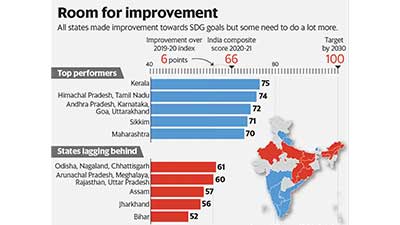Relevance: GS-2: Issues relating to Poverty and Hunger.
Key Phrases: MDPI, HDI, sanitation
Why in news?
- UNDP releases MDPI 2021 report
Analysis:
What is Multi-dimensional Poverty Index (MDPI)?
- MPI is based on the idea that poverty is not unidimensional (not just depends on income and one individual may lack several basic needs like education, health etc.), rather it is multidimensional.
- The Global Multidimensional Poverty Index (MPI) was developed in 2010 by the Oxford Poverty & Human Development Initiative (OPHI) and the United Nations Development Programme (UNDP)
- MPI uses three dimensions and ten indicators which are:
- Education: Years of schooling and child enrollment (1/6 weightage each, total 2/6);
- Health: Child mortality and nutrition (1/6 weightage each, total 2/6);
- Standard of living: Electricity, flooring, drinking water, sanitation, cooking fuel and assets (1/18 weightage each, total 2/6).
Findings of the report
- 1.3 billion people are multidimensionally poor-About half (644 million) are children under age 18
- Nearly 85% live in Sub-Saharan Africa (556 million) or South Asia (532 million). - More than 67% live in middle-income countries.
- Within a country, multidimensional poverty among different ethnic groups can vary immensely.
- Worldwide about two-thirds of multidimensionally poor people (836 million) live in households where no woman or girl completed at least six years of schooling.
Findings for India
- In India five out of six multidimensionally poor people are from lower tribes or castes
- 9.4% of the Scheduled Tribe group lives in multidimensional poverty
- 33.3% of the Scheduled Caste group lives in multidimensional poverty.
- Top five countries with the largest number of people living in multidimensional poverty are in India (2015/16) at 381 million

Reasons behind poverty in India?
- Population Explosion: India’s population has steadily increased through the years. During the past 45 years, it has risen at a rate of 2.2% per year, which means, on average, about 17 million people are added to the country’s population each year.
- Low Agricultural Productivity: A major reason for poverty in the low productivity in the agriculture sector. The reason for low productivity is manifold. Chiefly, it is because of fragmented and subdivided land holdings,
- Inefficient Resource utilisation: There is underemployment and disguised unemployment in the country, particularly in the farming sector. This has resulted in low agricultural output and also led to a dip in the standard of living.
- Low Rate of Economic Development: Economic development has been low in India especially in the first 40 years of independence before the LPG reforms in 1991.
- Social Factors: Apart from economic factors, there are also social factors hindering the eradication of poverty in India. Some of the hindrances in this regard are the laws of inheritance, caste system, certain traditions, etc.
- Climatic Factors: Most of India’s poor belong to the states of Bihar, UP, MP, Chhattisgarh, Odisha, Jharkhand, etc. Natural calamities such as frequent floods, disasters, earthquake and cyclone cause heavy damage to agriculture in these states.
- While a large number of poverty alleviation programmes have been initiated, they function in silos. There is no systematic attempt to identify people who are in poverty, determine their needs, address them
- Resources allocated to anti-poverty programmes are inadequate and there is a tacit understanding that targets will be curtailed according to fund availability. For instance, Mahatma Gandhi National Rural Employment Guarantee Act does not provide the guaranteed 100 days of work in many states.
- India’s women have been withdrawing from the labour force since 2005and less than one-third of working-age women are now in the labour force. As a result, India today ranks last among BRICS countries
Current status of poverty
- From 2011 to 2019, the number of poor in India was estimated to have decreased to 78 million from 340 million.
- In 2020, the number increased by 75 million due to lockdown
- The middle class in India is estimated to have shrunk by 3.2 crores in 2020.
- The richer population also fell almost 30% to 1.8 crore people.
Government efforts
- Swarnajayanti Gram Swarozgar Yojana: Swarnajayanti Gram Swarozgar Yojana
- Pradhan Mantri Awaas Yojana: It has two components: Pradhan Mantri Awaas Yojana (Grameen) and Pradhan Mantri Awaas Yojana (Urban)
- Mahatma Gandhi National Rural Employment Guarantee Act,2005: It provides 100 days of guaranteed employment to rural households.
- Pradhan Mantri Kaushal Vikas Yojana: It is a scheme aimed at the enhancement of skills based on the demand of the economy.
Way ahead
- The government must provide transparency and accountability to various organizations that are responsible for the implementation of the Welfare Schemes.
- The problem of the inability to determine the poverty line must be resolved to help the target population.
- Investment in Agriculture by the government is necessary to decrease rural poverty. Subsidies address only short-term issues. Also, there is a need to develop technologies, with the help of which farmers can practice all-weather agriculture.
- Resilience for poor households to withstand major shocks: through holistic, multi-faceted intervention designed to help people lift themselves from extreme poverty by providing them with the tools, skills, and resources required
Source: The Hindu BL
Mains Question:
Q. The social diversity in India makes the fight against poverty a complex task. While explaining the emerging patterns of poverty, list the measures taken by private and public sector to address this problem. (15 Marks, 250 Words)









